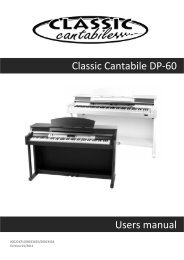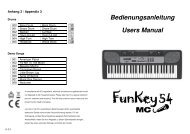Pronomic PMX-1804FX Users manual - Musikhaus Kirstein
Pronomic PMX-1804FX Users manual - Musikhaus Kirstein
Pronomic PMX-1804FX Users manual - Musikhaus Kirstein
Create successful ePaper yourself
Turn your PDF publications into a flip-book with our unique Google optimized e-Paper software.
<strong>PMX</strong> Series Mixer<br />
CLIP-LED<br />
The CLIP LED lights up when the input signal is driver too high. In this case, turn down the TRIM<br />
control and, if necessary, check the setting of the channel EQ.<br />
SOLO<br />
The SOLO switch is used to route the channel signal to the solo bus (Solo In Place) or to the PFL bus<br />
(Pre Fader Listen). This enables you to monitor a channel signal without afecting the main output signal.<br />
The signal you hear is sourced either before (PFL, mono) or after (solo, stereo) both the pan control and<br />
the channel fader (see chapter 2.3.6 “Level meters and monitoring”).<br />
The channel fader determines the level of the channel signal in the main mix (or submix).<br />
6<br />
LEVEL<br />
+4<br />
-10<br />
LINE IN 7/8<br />
MONO<br />
L<br />
BAL<br />
OR<br />
UNBAL<br />
Fig. 2.5: Stereo channel<br />
inputs and LEVEL switch<br />
R<br />
2.2 Stereo channels<br />
2.2.1 Channel inputs<br />
Each stereo channel has two balanced line level input on<br />
1/4" connectors for left and right channels. If only the connector<br />
marked “L” is used, the channel operates in mono. Stereo<br />
channels are designed to handle typical line level signals.<br />
Both input can also be used with unbalanced jacks.<br />
LEVEL<br />
For level matching, the stereo inputs feature a LEVEL switch<br />
which selects between +4 dBu and -10 dBV. At -10dBV (homerecording<br />
level), the input is more sensitive than at +4 dBu<br />
(studio level).<br />
2.2.2 Equalizer stereo channels<br />
The equalizer of the stereo channel is, of course, stereo. The filter characteristics and crossover<br />
frequencies are the same as those of the mono channels. A stereo equalizer is always preferable<br />
to mono equalizers if frequency correction of a stereo signal is needed. There is often a discrepancy<br />
between the settings of the left and the right channels when using separate equalizers.<br />
2.2.3 Aux sends stereo channels<br />
In principle, the aux sends of the stereo channels function in just the same way as those of the mono<br />
channels. As aux send paths are always mono, the signal on a stereo channel is first summed to mono<br />
before it reaches it reaches the aux bus.<br />
2.2.4 routing switch, solo and channel fader<br />
BAL<br />
The function of the BAL(ANCE) control corresponds to the PAN control in the mono channels.<br />
The balance control determines the relative proportion between the left and right input signals before<br />
both signals are routed to the main stereo mix bus.<br />
The MUTE/ALT 3-4 switch, the MUTE-LED, the CLP-LED, the SOLO switch and the channel fader<br />
function in the same way as the mono channels.<br />
<strong>PMX</strong> Series Mixer<br />
The PAN control in the channel strip offers a constant power characteristic. This means that<br />
the signal is always at a constant level, irrespective of its position in the stereo panorama.<br />
If the PAN control is moved fully left or right from center, the level increases by 4 dB in that<br />
channel. This signal is not louder. For this reason, with the solo function activated (Solo In<br />
Place), audio signals from the channels with PAN controls that have not be moved fully to<br />
the left or right are displayed at a lower volume that in the PFL function.<br />
Also a rule, solo signals are monitored via the control room output and headphones connector and are<br />
displayed by the level meters. If a also switch is pressed, the signals from the tape input, Alt 3-4 and main<br />
mix are blocked from the control room outputs, the headphone connector and the level meter.<br />
MAIN SOLO<br />
The MAIN SOLO LED lights up as soon as a channel or aux send solo switch is pressed. The MODE<br />
switch also has to be set at “solo”.<br />
PFL<br />
The PFL LED indicates that the peak metre is set to PFL mode.<br />
PHONES<br />
You can connect headphone to this 1/4" TRS connector. The signal on the PHONES connection is<br />
sourced from the control room output.<br />
2.3.7 Alt 3-4 and main mix fader<br />
PHONES<br />
Fig. 2.12: PHONES connector<br />
10<br />
0<br />
10<br />
15<br />
20<br />
25<br />
30<br />
40<br />
60<br />
8<br />
3 4 L R<br />
10<br />
0<br />
10<br />
15<br />
20<br />
25<br />
30<br />
40<br />
60<br />
8<br />
ALT 3-4 MAIN MIX<br />
Fig. 2.13: Alt 3-4 and main mix fader<br />
Use the high-precision quality faders to control the output level of the Alt 3-4 subgroup and main mix.<br />
10<br />
0<br />
10<br />
15<br />
20<br />
25<br />
30<br />
40<br />
60<br />
8<br />
10<br />
0<br />
10<br />
15<br />
20<br />
25<br />
30<br />
40<br />
60<br />
8<br />
11
















